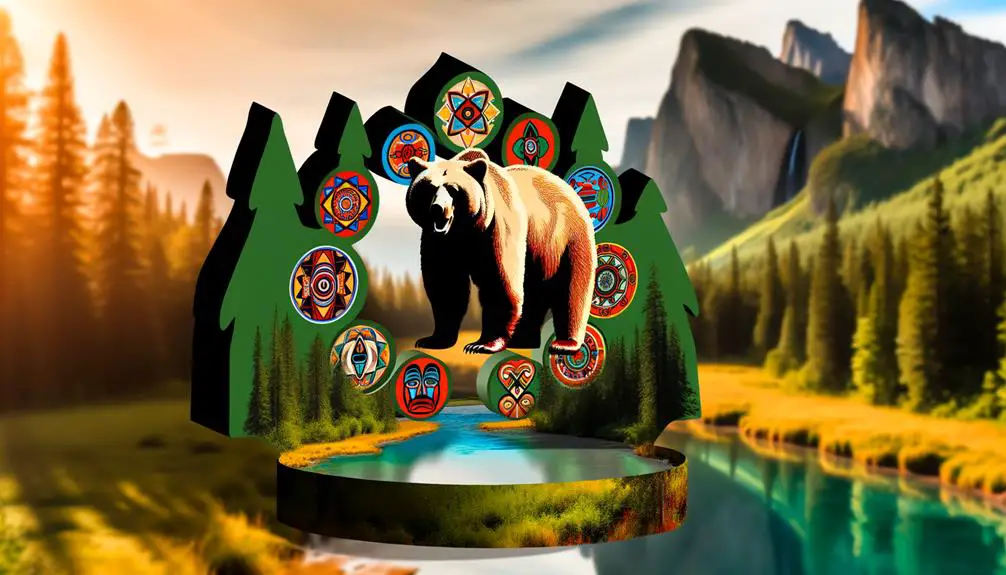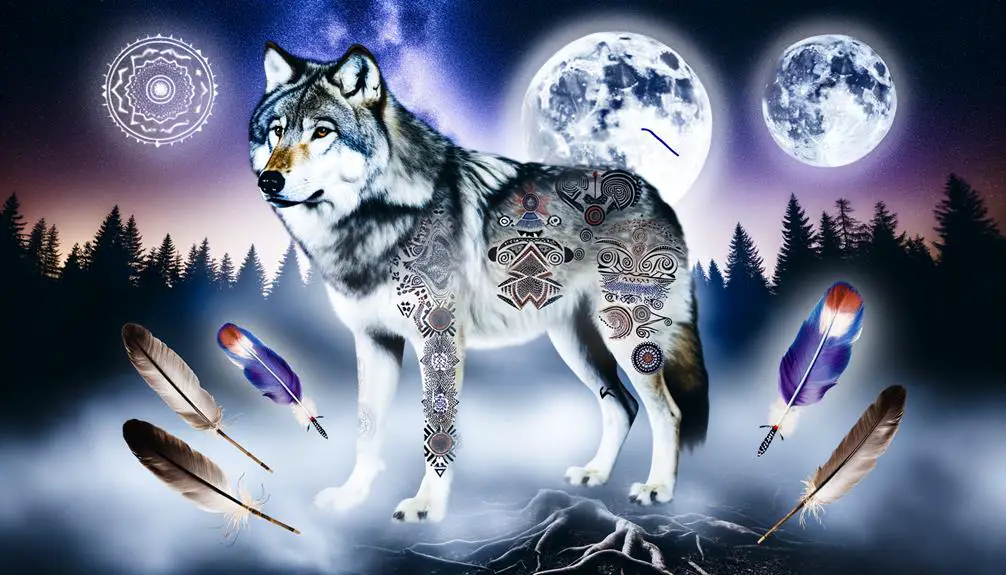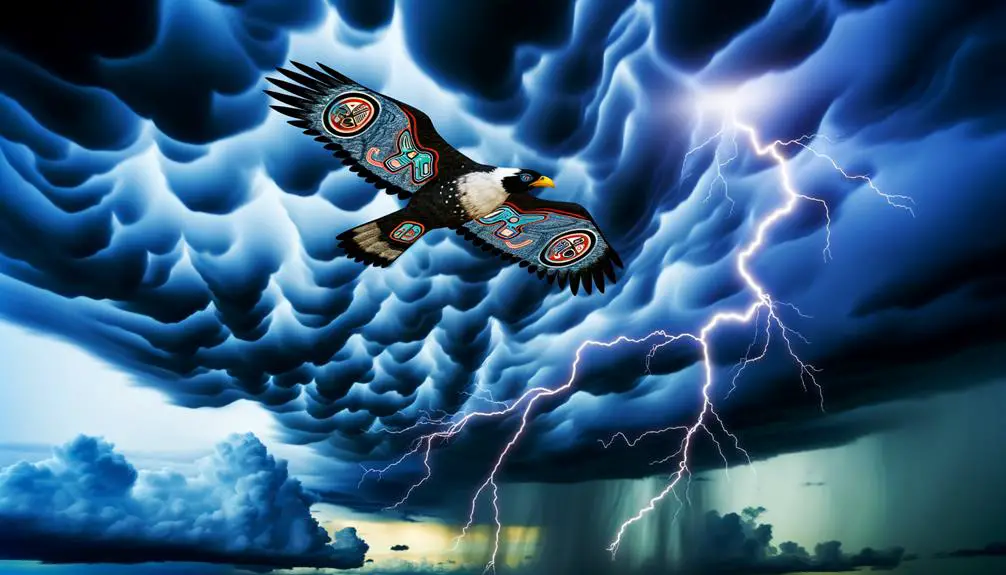What Are Native American Symbol Meanings?
Native American symbols hold profound significance in the cultural and spiritual practices of Indigenous tribes. The Eagle embodies strength, vision, and divine connection, while the Bear symbolizes courage, healing, and earth-bound wisdom.
The Wolf, a powerful spirit guide, represents loyalty and intuition. The Turtle signifies longevity, patience, and foundational elements of Earth.
Mythological symbols like the Thunderbird stand for power and protection, and the Dreamcatcher acts as a talisman for safeguarding dreams. Celestial symbols such as the Sun symbolize life, energy, and spiritual guidance.
These symbols encapsulate complex spiritual wisdom and cultural narratives. Exploring further uncovers deeper layers of their meanings.

Key Takeaways
- The Eagle symbolizes strength, vision, and spiritual ascension in Native American culture.
- The Bear represents courage, leadership, and a deep connection to the earth.
- The Wolf signifies loyalty, intuition, and communal strength, acting as a powerful spirit guide.
- The Thunderbird symbolizes power, protection, and acts as a mediator between earthly and spiritual realms.
- The Dreamcatcher is a protective talisman representing the spiritual significance of dreams and life's interconnectedness.
The Eagle

The eagle, revered as a powerful symbol in Native American culture, represents strength, vision, and a connection to the divine. Many tribes, including the Lakota, Hopi, and Navajo, hold the eagle in high esteem, viewing it as a messenger between humans and the Creator.
The bird's flight, soaring to great heights, is seen as a metaphor for spiritual ascension and insight. Eagle feathers, often used in sacred ceremonies, embody respect and honor. They are meticulously cared for, reflecting the cultural significance and deep spiritual connection attributed to the eagle.
Understanding the eagle's role in Native American traditions requires recognizing its profound symbolism as a bridge between earthly existence and spiritual domains, embodying revered principles of wisdom and power.
The Dreamcatcher

A quintessential artifact in Native American culture, the dreamcatcher serves as a protective talisman designed to safeguard individuals from negative dreams and energies. Originating from the Ojibwe people, the dreamcatcher is traditionally crafted from a willow hoop, sinew, and adorned with feathers and beads.
The intricate web at its center is believed to filter dreams, allowing only positive visions to pass through, while trapping nightmares until the morning sun dissolves them. This symbolic object reflects deep cultural beliefs about the spiritual significance of dreams and the interconnectedness of life.
Its use and meaning have since been adopted by various tribes, each incorporating unique elements that reflect their traditions and spiritual practices, preserving its revered status in Native American heritage.
The Bear

In Native American symbolism, the bear embodies strength, courage, and leadership, reflecting both physical prowess and spiritual guardianship within various tribal traditions. Often revered as a powerful totem, the bear represents a profound connection to the earth and its cycles. This majestic creature is associated with introspection, healing, and the capacity to face challenges with resilience.
- Spiritual Guidance: Bears are seen as spiritual guides, leading individuals toward self-discovery.
- Healing Powers: Many tribes believe in the bear's ability to heal both physical and emotional wounds.
- Protection: Bears are regarded as protectors, offering safety to those who invoke their spirit.
- Seasonal Symbolism: Hibernation habits link the bear to cycles of renewal and transformation.
Such symbols reveal the deep respect and admiration Native Americans hold for the bear.
The Wolf

The wolf holds multifaceted significance in Native American cultures. Often revered as a powerful spirit guide embodying intelligence, loyalty, and communication. Different tribes, such as the Cherokee and the Pawnee, include the wolf within their clan systems. Each attributing unique social and spiritual roles to this animal.
Additionally, numerous Native American myths and legends feature the wolf. Highlighting its importance in cosmological narratives and moral teachings.
Wolf as Spirit Guide
Often revered in Native American cultures, the wolf is considered a powerful spirit guide symbolizing loyalty, courage, and the deep connection to one's instincts. As a spirit guide, the wolf aids individuals in traversing life's complexities with confidence and integrity. This revered animal embodies the essence of guidance and protection, often leading individuals to deeper self-awareness and understanding.
- Loyalty: Wolves are known for their strong social bonds and family structures.
- Courage: The wolf emboldens individuals to face challenges head-on.
- Instinct: Emphasizes the importance of trusting one's innate wisdom.
- Guidance: Acts as a spiritual mentor, steering one towards personal growth.
Understanding the wolf as a spirit guide offers profound insights into Native American spiritual practices and values.
Wolf Clan Significance
Among many Native American tribes, the Wolf Clan holds significant cultural and spiritual importance, symbolizing traits such as leadership, intuition, and communal strength. The Wolf Clan often serves as a model for social structure, reflecting the wolves' complex pack hierarchy and cooperative hunting strategies. Members of the Wolf Clan are frequently regarded as natural leaders, embodying the wolf's keen sense of direction and ability to guide others.
This clan's emphasis on community mirrors the wolves' dependency on group cohesion for survival. Additionally, the Wolf Clan is associated with profound intuitive abilities, highlighting the wolf's acute senses and heightened awareness. The clan's values and attributes are deeply embedded in the cultural practices, ceremonies, and governance of the tribes that honor it.
Wolf in Mythology
In various Native American mythologies, the wolf is revered as a powerful and multifaceted symbol, representing both the physical and spiritual domains. The wolf often embodies attributes such as loyalty, leadership, and keen intuition. This esteemed creature is frequently depicted in stories, rituals, and tribal lore, reflecting its integral role within Native American cultures.
- Spiritual Guide: The wolf is seen as a spiritual guide, offering wisdom and insight.
- Symbol of Community: Represents the importance of family and social structure.
- Cultural Hero: Often portrayed as a hero in mythological tales, embodying bravery and cunning.
- Transformation: Associated with personal growth and transformation, symbolizing the journey of life.
These elements underscore the wolf's profound significance within Native American belief systems.
The Thunderbird

The Thunderbird holds profound mythological significance in various Native American cultures, often symbolizing power, protection, and divine intervention.
Representations of the Thunderbird can be found in numerous cultural artifacts, including totem poles, pottery, and oral traditions, each reflecting the unique beliefs and values of different tribes.
Its depiction as a colossal, supernatural bird capable of generating thunder and lightning underscores its revered status within these communities.
Mythological Significance
Revered across numerous Native American cultures, the Thunderbird stands as a potent symbol of power and protection, embodying the awe-inspiring force of nature and the spiritual domain. This mythical creature, often depicted as a giant bird, is believed to command thunder, lightning, and rain, playing a vital role in both natural and spiritual spheres. Its significance varies among tribes, yet common themes persist, reflecting its universal reverence.
- Creation Myths: Integral to various creation stories, symbolizing the dawn of existence.
- Spiritual Intermediary: Acts as a mediator between the earthly realm and the spiritual world.
- Weather Control: Regarded as a controller of weather patterns, bringing rain and storms.
- Warrior Guardian: Seen as a protector of warriors, bestowing strength and courage.
This cultural icon exemplifies profound mythological importance, underscoring its esteemed status across diverse indigenous narratives.
Cultural Representations
Across various Native American tribes, the Thunderbird is symbolically represented in art, dance, and storytelling, each medium offering a unique lens through which its significance is conveyed.
In visual art, intricate carvings and totem poles capture the Thunderbird's majestic and powerful form, often characterized by outstretched wings and vibrant colors.
Dance rituals, such as those performed by the Kwakwaka'wakw people, embody the Thunderbird's strength and connection to the natural world, using elaborate costumes and rhythmic movements.
Storytelling traditions preserve its mythological essence, recounting tales of the Thunderbird's role in creation and its control over thunder and rain.
These cultural representations highlight the Thunderbird's multifaceted significance, reflecting its integral role in the spiritual and communal life of Native American societies.
The Turtle

Among various Native American tribes, the turtle holds profound symbolic significance. It often represents longevity, perseverance, and the foundational elements of Earth. The turtle's slow yet steady movement is emblematic of a life lived with patience and resilience. Additionally, the turtle's shell, resembling the shape of the Earth, signifies protection and a grounding connection to nature. This revered creature is featured prominently in several creation myths and cultural narratives.
The turtle has multiple symbolic meanings:
- Longevity and wisdom: The turtle's extended lifespan symbolizes enduring knowledge and experience.
- Perseverance: Its deliberate pace teaches the virtue of persistence.
- Creation stories: Many tribes believe the world was formed on the back of a giant turtle.
- Protection: The shell represents a safeguard against harm and adversity.
This multifaceted symbolism underscores the turtle's esteemed place in Native American culture.
The Sun

Similar to the turtle, the Sun occupies a significant place in Native American culture, symbolizing life, energy, and spiritual guidance. Various tribes venerate the Sun as a crucial force, integral to agricultural cycles and ceremonial practices. The Sun represents not only physical warmth and sustenance but also enlightenment and divine presence.
| Symbol | Meaning |
|---|---|
| Life | Vitality and Growth |
| Energy | Dynamic Force |
| Guidance | Spiritual Direction |
| Warmth | Comfort and Sustenance |
| Enlightenment | Divine Presence |
The Sun's daily journey across the sky is often seen as a metaphor for the human life cycle, from birth to death and rebirth. This celestial body is a common motif in art, storytelling, and religious ceremonies, underscoring its profound influence on Native American spirituality and daily life.
Conclusion
The tapestry of Native American symbols, from the majestic eagle to the steadfast turtle, weaves a rich narrative of cultural heritage and spiritual depth.
Each symbol serves as a beacon illuminating the values, beliefs, and cosmological views of diverse tribes.
Understanding these symbols not only fosters appreciation for their intricate meanings but also strengthens the bridge between past and present, ensuring that the wisdom of ancient traditions continues to resonate through the corridors of time.






